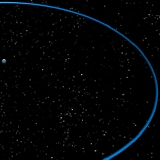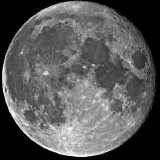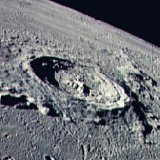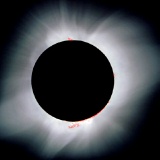 |
|||
|
Apollo 11 orbital view of the Sabine and Ritter area
of the Moon's surface.
|
|||
| THE MOON | |||
| The Moon, our nearest neighbour, has no discovery date, for surely it must have been known to humans for thousands of years. It has been part of the mythology of every civilisation through history, inducing mixed emotions - fear during eclipses, and a welcome light source during the night. Even with our modern technology, military campaigns have been timed according to the phase of the Moon - the Gulf War started at the time of New Moon, when there was no light from the Moon. With Earth and Mars, the Moon is one of the Solar System bodies from which we have rock samples, and, of course, the Moon is the only other body that has been visited by man. | |||
| Orbit | |||
 |
|||
|
The Moon's orbit.
|
|||
| The Moon orbits the Earth at a distance of 384,400 kilometres. The orbital eccentricity is 0.0549, so the Moon's perigee (closest point to Earth) is 363,296 kilometres. The greatest distance between the Earth and Moon, when the Moon is at its apogee point, is 405,503 kilometres. | |||
| The Moon rotates once on its axis in 27.3216 days - this is the same as its orbital period and therefore the Moon always keeps the same face presented to Earth. However, the Moon's orbital velocity varies, being fastest at perigee and slowest at apogee. The result is that there is a slight mismatch between the rotation and the orbital motion, and consequently the Moon appears to have a slight wobble, or libration. We can in fact see about 59% of the Moon's surface, though not all 59% at the same time. The Moon does not orbit the centre of the Earth, rather, the Earth and Moon orbit about the common centre of mass, or barycentre. The barycentre of the Earth-Moon system is located about 4,670 kilometres from the Earth's centre, in the Earth's mantle. | |||
| Over a long period of time, tidal friction within the Earth-Moon system has caused the Moon's rotation rate to slow down. The Earth's rotation has also slowed - we used to have a day of less than 22 hours about 360 million years ago. Growth rings in fossil coral indicate that the tidal period used to be different, and hence the Moon's orbital period must have been different. The slowing down of the Earth-Moon system, which is still occurring, results in the Moon slowly moving away from Earth at a rate of about 4 centimetres per year. The length of our day simultaneously increases by 0.002 seconds per century. | |||
| We will not lose our Moon. The Moon's orbit will continue to expand, until the length of an Earth day is the same as a lunar month. This will occur when our day is 47 days long, and the Earth-Moon system has achieved a stable synchronisation. | |||
 |
|||
| Comparison between Earth and Moon. | |||
| Magnetic field | |||
| No magnetic field has been detected, and hence there is no dynamo effect from a rotating metal-rich core. Magnetism has been detected in rock samples from the surface of the Moon, but this may be "fossil" magnetism. | |||
| Interior | |||
| We have no samples from the Moon's mantle - only from the surface, and so our knowledge of the Moon's interior comes from studying the effects of lunar gravity on orbiting spacecraft. It is still unknown whether or not the Moon has a core, but is is likely that the centre of the Moon is still molten. The lack of a lunar magnetic field rules out a rotating metal core. | |||
| More about the Moon's structure | |||
| Physical properties | |||
| The Moon has 27% the volume of Earth, but only 1.2% the mass. This is because the density of the Moon is much lower than Earth's, at 3,344 kgxm-3. | |||
| The lower mass and size of the Moon means that lunar escape velocity is 2.376 kilometres s-1. This is lower than Earth's escape velocity, and it is easier to launch into orbit from the Moon than it is from Earth. A large rocket is needed to get people off the Earth and on the way to the Moon, but once there, a lunar module with a small engine can leave the Moon's surface and make the return trip. | |||
| Surface | |||
| Our quest for an understanding of the lunar surface can be said to have begun in earnest when Galileo used the newly invented telescope to make his first observations. He made sketches of the cratered surface and even measured the heights of the mountains by observing the length of the shadows they cast. More powerful telescopes gradually revealed more and more detail, and maps of the Moon grew in complexity. Since the Apollo mission, the most intense phase of lunar exploration, we have a far better understanding of how our nearest companion evolved and how its surface has been shaped. | |||
 |
|||
| The dark mare and bright highlands are apparent to the naked eye. | |||
| More about the Moon's surface. | |||
| Craters and basins | |||
| The Moon's surface is heavily cratered, similar to Mercury. Some of the craters, with bright ejecta rays, are visible from earth with the naked eye. Many others can be seen with binoculars or small telescopes. The Moon also has large impact basins. | |||
 |
|||
| Eratosthenes crater, as photographed from Apollo 17 in orbit. | |||
| More about lunar craters | |||
| More about the Moon's impact basins | |||
| Atmosphere | |||
| There are occasional reports of some form of outgassing from the surface of the Moon, or a local brightening, particularly near Alphonsus crater. Such phenomena are called TLPs, or Transient Lunar Phenomena. Their nature, and even whether or not they really exist, is still being debated. Apart from TLPs, the Moon has no substantial atmosphere. There are small amounts of oxygen, hydrogen and helium. Recent results from the Clementine spacecraft suggest that there may be water ice in the permanently dark craters of the polar regions. If so, the establishment of a lunar base would become much easier. | |||
| The lack of an atmosphere, which would act as a thermal blanket, means the Moon's surface is exposed to the full heat of the Sun - a heat it radiates rapidly into space during the lunar night. The average daytime lunar temperature is 107oC whereas the nighttime temperature is -153oC. | |||
| The formation and evolution of the Moon | |||
| The size of the Moon is such that the Earth-Moon system can be considered a double planet, similar to the Pluto-Charon system. Therefore, the Moon should be orbiting the Sun, and not orbiting the Earth. There are a variety of theories attempting to explain the origin of the Moon, but the most likely one (at the time of writing) has the Moon born out of a catastrophic collision between the Earth and another large body. | |||
| More about the formation and evolution of the Moon | |||
| Eclipses | |||
| The Moon, as well as being eclipsed itself, can also eclipse the Sun, and in so doing produces one of the most awe-inspiring spectacles in the Solar System. The solar corona becomes visible, prominences can be seen, and the observer's surroundings are plunged into night in the middle of the day. | |||
 |
|||
| The solar corona and prominences are visible during a total eclipse. | |||
| More about eclipses | |||
| The exploration of the Moon | |||
| The Moon, being our nearest neighbour, has been the target of extensive exploration. The Apollo program is to date one of the greatest technological achievements of the human race. Lunar exploration continues today with future spacecraft missions being planned. | |||
| More about the exploration of the Moon | |||
|
|
|||